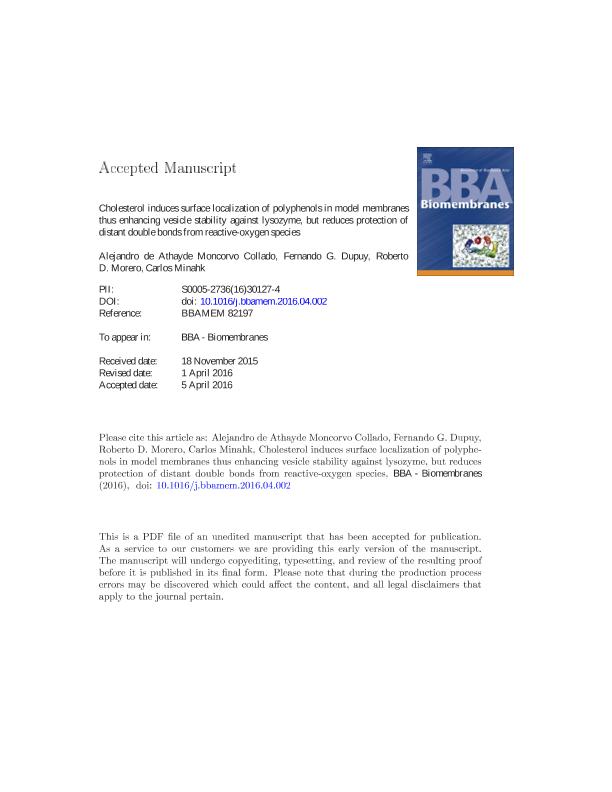Artículo
Cholesterol induces surface localization of polyphenols in model membranes thus enhancing vesicle stability against lysozyme, but reduces protection of distant double bonds from reactive-oxygen species
de Athayde Moncovo Collado, Alejandro ; Dupuy, Fernando Gabriel
; Dupuy, Fernando Gabriel ; Morero, Roberto Dionisio
; Morero, Roberto Dionisio ; Minahk, Carlos Javier
; Minahk, Carlos Javier
 ; Dupuy, Fernando Gabriel
; Dupuy, Fernando Gabriel ; Morero, Roberto Dionisio
; Morero, Roberto Dionisio ; Minahk, Carlos Javier
; Minahk, Carlos Javier
Fecha de publicación:
07/2016
Editorial:
Elsevier Science
Revista:
Biochimica et Biophysica Acta - Biomembranes
ISSN:
0005-2736
Idioma:
Inglés
Tipo de recurso:
Artículo publicado
Clasificación temática:
Resumen
The main scope of the present study was to analyze the membrane interaction of members of different classes of polyphenols, i.e. resveratrol, naringenin, epigallocatechin gallate and enterodiol, in model systems of different compositions and phase states. In addition, the possible association between membrane affinity and membrane protection against both lipid oxidation and bilayer-disruptive compounds was studied. Gibbs monolayer experiments indicated that even though polyphenols showed poor surface activity, it readily interacted with lipid films. Actually, a preferential interaction with expanded monolayers was observed, while condensed and cholesterol-containing monolayers decreased the affinity of these phenolic compounds. On the other hand, fluorescence anisotropy studies showed that polyphenols were able to modulate membrane order degree, but again this effect was dependent on the cholesterol concentration and membrane phase state. In fact, cholesterol induced a surface rather than deep into the hydrophobic core localization of phenolic compounds in the membranes. In general, the polyphenolic molecules tested had a better antioxidant activity when they were allowed to get inserted into the bilayers, i.e. in cholesterol-free membranes. On the other hand, a membrane-protective effect against bilayer permeabilizing activity of lysozyme, particularly in the presence of cholesterol, could be assessed. It can be hypothesized that phenolic compounds may protect membrane integrity by loosely covering the surface of lipid vesicles, once cholesterol push them off from the membrane hydrophobic core. However, this cholesterol-driven distribution may lead to a reduced antioxidant activity of linoleic acid double bonds.
Archivos asociados
Licencia
Identificadores
Colecciones
Articulos(INSIBIO)
Articulos de INST.SUP.DE INVEST.BIOLOGICAS
Articulos de INST.SUP.DE INVEST.BIOLOGICAS
Citación
de Athayde Moncovo Collado, Alejandro; Dupuy, Fernando Gabriel; Morero, Roberto Dionisio; Minahk, Carlos Javier; Cholesterol induces surface localization of polyphenols in model membranes thus enhancing vesicle stability against lysozyme, but reduces protection of distant double bonds from reactive-oxygen species; Elsevier Science; Biochimica et Biophysica Acta - Biomembranes; 1858; 7; 7-2016; 1479-1487
Compartir
Altmétricas



